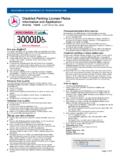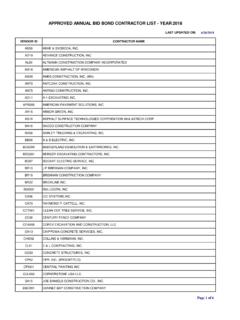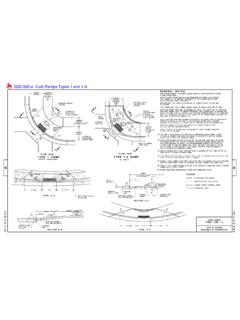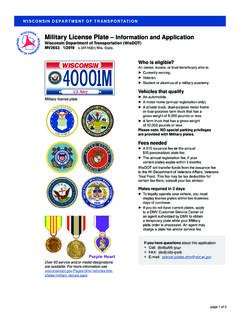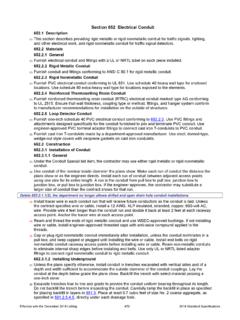Transcription of Facilities Development Manual Wisconsin Department of ...
1 Page 1 Facilities Development Manual Wisconsin Department of Transportation Chapter 11 Design Section 46 Bicycle and Pedestrian Accommodations FDM 11-46-1 Bicycle and Pedestrian Elements Affecting Complete Streets March 16, 2018 Introduction, Purpose, Definitions, Overview Complete streets are broadly defined as roadways designed and operated to enable safe, convenient, and comfortable access and travel for all users.
2 Pedestrians, bicyclists, motorists, and public transport users of all ages and abilities can move along and across a complete street with safety and comfort. Federal policy for providing bicycle and pedestrian accommodation - per the 2010 US DOT Policy Statement on Bicycle and Pedestrian Accommodation Regulations and Recommendations (Memorandum) (1) - is as follows: The DOT policy is to incorporate safe and convenient walking and bicycling Facilities into transportation projects. Every transportation agency, including DOT, has the responsibility to improve conditions and opportunities for walking and bicycling and to integrate walking and bicycling into their transportation systems. Because of the numerous individual and community benefits that walking and bicycling provide including health, safety, environmental, transportation, and quality of life transportation agencies are encouraged to go beyond minimum standards to provide safe and convenient Facilities for these modes.
3 Federal legislation currently requires that bicycle and pedestrian needs must be given due consideration under Federal Surface Transportation law (23 217(g)(1)), and this should include, at a minimum, a presumption that bicyclists, pedestrians, and persons with disabilities will be accommodated in the design of new and improved transportation Facilities . In the planning, design, and operation of transportation Facilities , bicyclists, pedestrians, and persons with disabilities should be included as a matter of routine, and the decision to not accommodate them should be the exception rather than the rule. There must be exceptional circumstances for denying bicycle and pedestrian access (23 217(g)(1)). Federal Highway Administration (FHWA) policy requires the inclusion of bicycle and pedestrian accommodation on all new and reconstruction projects, with three exceptions: 1.
4 Bicyclists and pedestrians are prohibited by law from using the roadway. 2. The cost of establishing bikeways would be excessively disproportionate to the need or probable use. Excessively disproportionate is defined by FHWA and state statutes as bicycle and pedestrian Facilities together exceeding 20 percent of the cost of the larger transportation project . 3. Sparsity of population or other factors indicate an absence of need. The FHWA Wisconsin Division Office directs that the WisDOTshall follow federal policy on all projects on the National Highway System (NHS), and should follow federal policy on all federally funded projects off that system. WisDOT policy, in conformance with Federal laws and policy, State Statute Section (35), and Connections 2030 (2) (3), requires that projects must give due consideration to establishing bicycle accommodations and pedestrian Facilities on all new construction and reconstruction highway projects funded in whole or in part from state or federal funds.
5 After giving due consideration, if WisDOT determines that bike and pedestrian Facilities are required on a project funded in whole or in part from state funds, then WisDOT is authorized to include those Facilities only if each municipality1 in which the project is located adopts a resolution authorizing WisDOT to establish a bikeway or pedestrian way. The state statute also states that the need for WisDOT to obtain a municipal resolution(s) does not apply if FHWA provides written notice that establishment of a bikeway or pedestrian way, as part of a project , is a condition of the use of federal funds for that project ( (35)(d)(2), Wis. Statutes.) FHWA has indicated that when the results of due consideration show that bicycle and pedestrian Facilities are to be provided, the signed final National Environmental Policy Act (NEPA) decision document is FHWA s written notice to WisDOT that establishment of a bikeway or pedestrian way as part of the project , is a condition of the use of FHWA funds, consistent with State Statute (35)(d).
6 Therefore, for projects with any federal funding and those on the NHS, WisDOT s compliance with the FHWA written notice provision are satisfied by receipt of a completed environmental document from FHWA. However, even if the project does not require a resolution, 1 Municipality is defined as a city, village, or town (Wis. Statutes Section (22). FDM 11-46 Bicycle and Pedestrian Accommodation Guidance Page 2 the planning and design processes will still provide opportunities for public input and to evaluate environmental impacts of project alternatives that may include bike and pedestrian Facilities .)
7 Municipalities may adopt resolutions that authorize the inclusion of Facilities on the NHS or federal funded projects where WisDOT does not need to obtain them. These resolutions will be included in the environmental document. Department policy for other project types, such as resurfacing or reconditioning, requires an evaluation to include bicycle and pedestrian accommodations where possible/practical within the scope of the project . In addition, certain bicycle and pedestrian design practices are required when applicable, , curb ramps and bicycle-acceptable grates. The purpose of this procedure is to explain the requirements and applications of the state statute, WisDOT policy and federal laws and policies as they pertain to highway projects in Wisconsin .
8 State Statute State Statute (35) was originally created in 2009 and was modified in 2014. The modifications to the state statute became effective on July 14, 2015. Projects with approved environmental documents as of July 14, 2015 will follow through on the commitments identified during the public involvement and environmental processes including bike and pedestrian commitments 2. The state statute requires that WisDOT shall give due consideration to establishing bikeways, as defined in State Statute (1)(a), and pedestrian ways, as defined in State Statue (8)(a), on new highway construction and reconstruction projects funded in whole or in part from state funds or federal funds. The statute also states that the WisDOT may not establish bicycle and pedestrian ways if any of the following apply: 1.
9 Bicycles and pedestrians are prohibited by law from using the highway; or 2. The project is wholly or partially funded with state funds, unless the governing body of each municipality within the project has adopted a resolution authorizing the Department to establish the bikeway or pedestrian way. This subdivision does not apply if the federal government provides written notice to the Department that establishment of a bikeway or pedestrian way as a part of a project is a condition of the use of federal funds for that project . If after giving due consideration it is determined that establishment of bicycle and pedestrian Facilities are proposed on a reconstruction (including pavement replacement) or new construction improvement project that is not part of the NHS system and has no federal funding, then WisDOT cannot establish those Facilities unless each municipality3 involved in the new construction or reconstruction project adopts an official resolution authorizing the establishment of those Facilities as part of the improvement project .
10 This requires consensus amongst all the governing bodies in which a portion of the project will occur. For this situation, WisDOT will not finalize an environmental document that recommends providing a bike or pedestrian accommodation unless the aforementioned resolutions have been adopted. As stated previously in FDM 11-46-1, for projects with any federal funding and those on the NHS, WisDOT compliance with the FHWA written notice provision are satisfied above by receipt of a completed environmental document from FHWA. Therefore, WisDOT will not seek municipal resolutions on these types of projects (NHS or federal funded). Further, a resolution is not required when bicycle and pedestrian Facilities already exist and are to be replaced as part of the reconstruction or new construction improvement project .
